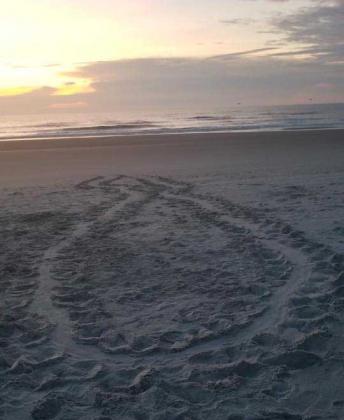The 2020 sea turtle nesting is off to a busy start, according to the Beaches Sea Turtle Patrol. Since May 1, volunteers have charted a number of nests. They have also counted a higher than average number of false crawls, which occurs when a female turtle exits the water without nesting.
Jennifer Burns, director of Beaches Sea Turtle Patrol, said Tuesday that false crawls are outnumbering nests by approximately three to one so far this season, which is very unusual. The typical ratio is about 50 percent false crawls. A false crawl is an emergence that does not result in a nest.
“We closed the gap [Monday] night a little bit but as of today, they were running about three false crawls per one nest,” she said. “It should only be 40 to 50 percent of our total nest count so that was quite a substantial difference. We did make up some ground so it’s running about two to one, as of [Tuesday].”
A number of environmental factors could result in a false crawl including obstacles, wildlife and human interference.
“It is most likely when people are around or there’s lights or animals or sometimes, they just kind of crawl out and check out the scene and then crawl back for no discernible reason. There really isn’t any way to tell,” Burns said.
“Sometimes there are obvious clues. Turtles can’t reverse so they have to either go around it or over it. If we happen to see a lot of footprints around where a crawl has turned, then we can kind of surmise that there were people there that scared it off. Things we can point to as an obvious cause are not always obvious.”
Last year, volunteers identified a total of 91 false crawls during the season. The numbers were later broken down by species with 89 loggerheads and two false greenback crawls.
This year, Burns said volunteers were excited to discover a rare leatherback nesting in the sands of Jacksonville Beach Monday night. The turtles, which are typically found in south Florida, are significantly larger than the loggerhead turtles that frequent the area during nesting season. Leatherbacks range between 600 and 800 pounds. A typical crawl pattern can be up to six feet in width. Each nest, which is called a “clutch,” can house up to 80 eggs. Loggerhead nests can hold an average clutch of up to 120 eggs. There were no leatherback nests or false crawls recorded last season.
Burns estimated the female spotted this week to be on the smaller side at 500 pounds.
“We were able to get some folks out there to protect the nest and the turtle made it safely back to sea,” she said, urging beach goers not to disturb turtles or nests, especially in a crowded area. “That would have been a very likely scenario for her to make a false crawl. It’s a rare species for North Florida. South Florida tends to get a lot more leatherbacks but its one of the rarer species throughout the state.”
Hurricane season, which began Monday, creates yet another obstacle for sea turtles to navigate, but Burns said females are known to “hedge their bets” by nesting multiple times.
“The turtles do have a nesting strategy. Each turtle will nest multiple times throughout the season so at least some of their nests will survive. If we have a hurricane come by in the middle of the season and they’ve nested early, those nests will probably be fine,” she said.
“It’s also natural incidents that just occur. Whatever the conditions are at the time. Weather forecasters aren’t really accurate when it comes to predicting some of the storms. It’s really anybody’s guess. Even though this is science, there are really a lot of unknowns. It’s just the way nature goes.”

